| Botanical Name |
|
| Family |
Euphorbiaceae - The euphorbia family. |
| Pronunciation |
yoo-FOR-bee-uh see-roo-LES-enz |
| Common Name(s) |
Afrikaans: Noorsdoring; Noorspol; Soetnoorsdoring; Vaalnoors
|
| Plant Group |
- Succulent A plant having fleshy stems or leaves often adapted to dry conditions.
|
| Plant Size |
- Very large
| Tree | Over 25m |
| Shrub | Over 4m |
| Perennial/ground cover | Over 1m |
| Bulb | Over 1.2m |
| Succulent | 1.5m to 2m |
|
| Position |
- Sun The area is in full sun for all or most of the day, all year round.
|
| General Information |
- Attractive fruits, berries or seeds Brightly coloured fruits or berries increase and extend the visual impact of the plant and are especially attractive to birds and other small wildlife.
- Drought Tolerance: High The plant is well adapted to arid conditions; it can survive long periods of drought and high temperatures without extra water.
- Evergreen Plants that have leaves all year round.
- Frost: Hardy The plant can withstand freezing temperatures or frost without artificial protection.
- Thorns / Spines / Prickles Thorn: A hard, woody, pointed branchlet.
Spine: A modified leaf forming a hard, sharp-pointed outgrowth.
Prickle: A small, sharp-pointed outgrowth growing from the bark of the plant.
- Water Wise Plant species originating from low rainfall regions that require less water to survive and thrive than other plant species.
- Wind Tolerant Plants able to withstand the effect of strong winds.
|
| Specific Information |
Euphorbia coerulescens is a medium-sized shrub with a number of upright branches that join at a single short stem, close to the ground. The stems are longitudinally ridged with four to six angles and paired thorns along the margins. Each branch is further constricted into segments of 4 - 8 cm long, reportedly reflecting periods of rapid and minimal growth. The stems are usually unbranched except at the tip. The leaves are very small, scale-like and are only found on young growth for a brief period. This plant spreads by rhizomes into large colonies of tightly packed branches. Euphorbia coerulescens can withstand temperatures down to -12º C.
As with most Euphorbias the milky latex can irritate the skin and produces a burning sensation in the throat if swallowed. The latex can irritate the eyes and can cause blindness. If you come in contact with the sap, wash hands with soap and water, taking care to not touch face or eyes.
|
| Ad Break |
|
| Flowers |
| Description |
cyathia ('flowers') are arranged in cymes (clusters) at the branch tips
|
| Season |
- Spring to Summer Plants will seldom bloom for the entire season as given in the list, but should flower during a period within these parameters.
|
| Colour |
|
| Growth Rate |
- Moderate Specifying growth rate can be very misleading as there is considerable variation of growth rate depending on type and species of plant, available water, supplementary feeding, mulching and general care, as well as the plants suitability and adaptability to the garden environment.
|
| Plant Uses |
- Accent or Focal Point A plant used to attract the attention because of its colour or form.
- Attracts bees, butterflies or other insects This plant attracts insects which can be food for birds or other creatures in your garden.
- Barrier Plant A very thorny shrub, tree or scrambler that can be used to create an impenetrable barrier.
- Boundary A plant useful for planting around the edges of the property to form a green or colourful backdrop, an impenetrable hedge, to hide walls or create privacy.
- Container Trees, shrubs and ornamental species that can adapt to growing in a restricted environment.
- Filler Either a fast growing tree or shrub used temporarily to fill in an area while the permanent plants grow to a desired size, or a plant used to fill gaps in borders or beds.
- Foliage Plant Plants grown because their foliage is colorful or unique. Many of these plants have insignificant flowers.
- Rock Garden An area constructed of larger rocks, arranged naturally, to emphasise the use of stones as a main element. Generally plants used do not need a lot of care.
- Wild Garden An indigenous garden planted for the benefit of wildlife and birds. Provides food, water, a variety of mini-biomes and no poisonous chemicals are used.
|
| Distribution and Habitat |
in the Western Cape in the Calitzdorp area in the Little Karoo, and in the Eastern Cape, in arid Karoo habitat in the Jansenville area, also known as the Noorsveld
|
| Planting Suggestions |
Euphorbia coerulescens is ideal for rock gardens and slopes with good drainage. Plant in full sun or in a position that gets just a little shade. In semi-desert conditions, these plants should be protected from the hottest afternoon sun. Do not over water. This Euphorbia spreads from underground stems.
If signs of rotting occur, cut off all rotten sections and dry out the rest of the branch until all cuts have healed and there is no sign of rot. This section can then be rooted in coarse sand.
|
| Medicinal Uses |
Although Euphorbia coerulescens is not normally browsed by stock, it is used as supplementary fodder in times of drought, when it is cut into sections and left to wilt for a few days.
|
| Ad Break |
|


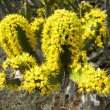
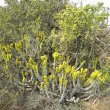
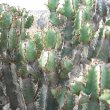
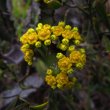
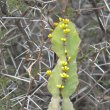
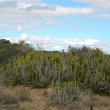
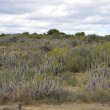


Discuss this plant
Share knowledge, ask a question or give an experience.